The vast majority of people now spend at least 40 hours a week sitting in a chair, staring at a screen. That is also a fairly generous number, considering most people get home from a day of work just to sit back down and watch tv or get on their computer at home. Spending this much time sitting in an unnatural position, as sitting in a chair is, without any movement leads to numerous health problems. Back pain, tightness in your hamstrings and legs, neck pain, heart problems, the list goes on and on. To help you avoid these issues, here are 5 yoga poses you can and should do at work, to improve your health and relieve pain. Getting up and spending a few minutes every hour going through these poses can provide you with health benefits to keep you feeling great.
Before we begin, you will notice that every pose has you starting in “mountain pose”. Mountain pose is the foundation for many standing yoga poses.
How to
- Begin standing with your toes touching and your heels slightly apart. Balance the weight between your feet and stabilize by spreading your toes and gripping the floor.
- Activate your thigh muscles. Lift your inner ankles and turn your upper thighs slightly inward. Lengthen your tailbone towards the floor.
- Widen your shoulder blades and lift your sternum toward the ceiling. Hang your arms at your sides and widen your collarbones.
- Imagine a line of energy flowing through your core. from your toes up through the crown of your head and lengthen your spine along that line of energy.
Once in mountain pose, you can progress to the other poses mentioned below.
1. Standing Forward Fold
The standing forward fold pose is an effective, easy to do pose that is perfect for the work place. Spending all day in a chair puts significant strain and pressure on your spine, and since our legs are bent it causes our hamstrings to tighten dramatically. Performing a standing forward fold allows you to stretch your hamstrings, taking pressure off of your back. It also helps your neck stretch, decompresses your neck and increases blood flow to the brain. This increased blood flow can give you cognitive benefits and even reduce stress and anxiety.
How To
- Begin in mountain pose, with your feet about sit bones distance apart. Bend forward from the hips as you exhale.
- Bring your hands to the floor or your ankles if you are able to do so. If not you can grab opposite elbows. Press through your heels and lift your hips.
- Following your breath, lift and lengthen the torso slightly as you inhale. As you exhale go deeper into the pose.
- Be sure to release any tension in your jaw and spine, and allow your torso to be as long as possible.
- When coming out of this pose, put hands to hips and inhale as you come up. Keep your torso long and push your heart and chest forward. Keep your core activated to protect your spine.
Be sure to listen to your body closely. You should not feel any pain during this pose so if you do come out of the pose gently but quickly.
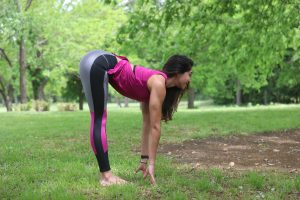
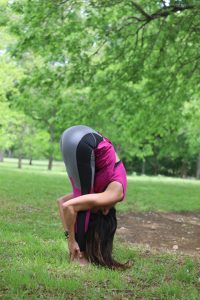
2. Malasana Squat
The malasana squat is how humans are thought to originally have been meant to sit and rest. The invention of chairs have caused us to stop using this form of sitting and has led to back problems and poor posture. Using this pose will help open the hips, decrease back pain and may even stimulate metabolism and the digestive tract.
How to
- Begin with your feet slightly wider than hips distance and have your toes pointing outward slightly.
- Begin to squat down until your hips drop lower than your knees. Do this slowly and carefully, your body is likely not used to doing this so it may take some patience and practice to fully get into this pose.
- Once your buttocks is just a few inches from the floor bring your palms to hearts center and push your elbows into the inside of your knees.
- Lengthen through your spine and keep your chest forward and high during this pose.
- While in this pose your toes, knees and hips should all be externally rotating to ensure the prevention of injury.
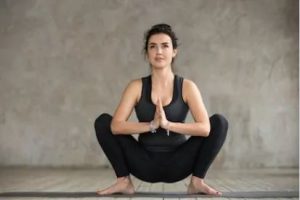
3. Chair Pose
Our body is made to move and be used. The amount of sitting we now do is leading to our muscles becoming weaker, which leads to improper posture and mechanics of movements. This then leads to back pain and other problems with out health. Chair pose is a great pose to use daily to help strengthen several muscle groups. Your legs are of course being activated, but you also activate your core, shoulders and back muscles. With so many muscle groups being activated you will also increase blood circulation, which also has health benefits for your heart and circulatory system.
How to
- Start in mountain pose, then exhale and begin to sit your hips down.
- As your knees bend your torso will lean forward until it forms a right angle with your thighs.
- Activate your shoulder blades and core, raising arms overhead with palms facing each other and parallel.
- Focus on your breath, sitting slightly deeper with each exhale.
You can hold this pose for 30 seconds to 1 minute. As always listen to your body. You should not feel any pain. Discomfort and some muscle burning is OK but be weary of any sharp or significant pain.
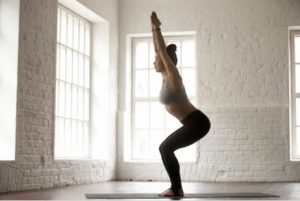
4. Cat & Cow Pose
Cat and cow pose are some of the most commonly used poses in yoga. While these might seem strange to do at work, especially if you don’t have a private office, the benefits far outweigh looking strange for a few minutes to your co-workers. Cat & cow pose increase flexibility of the neck, shoulders and spine, while also stretching the hips, abdomen, lungs, chest and back. For those who spend their day at a desk, this will help reverse many of those negative effects greatly. These poses also help strengthen and lengthen the spine. Cat and cow are also poses that flow with your breath. This can help stimulate blood circulation and energize the body and mind. The synchronization of breath with movement can also improve your focus and stability of mind.
How to
- Begin in table top position, on hands and knees. Shoulders over your wrists and hips over knees. Balance your weight between hands and legs as best you can.
- Start with a neutral spine and inhale, pushing your belly towards the floor. As you do this lift your gaze upward, opening your neck and chest. This puts you into cow pose.
- From cow begin to exhale, pulling your belly button in towards your spine. Push your chin down towards your chest and scoop your tailbone out arching your back (like a cat). This brings you into cat pose.
- Flow from cat to cow, back and forth, with your breath. You can go through this for however many cycles of breath as you like.
- Avoid bending your arms at the elbows.
- If you have any neck or back injuries be extremely cautious with these poses.
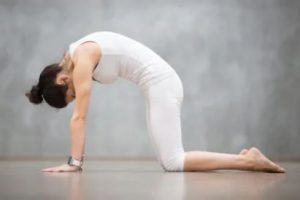
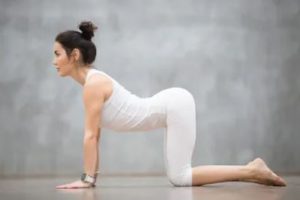
5. Extended Side Angle Pose
Our fifth and final yoga pose for works, is also probably the most difficult. This one may take some time to get down, so try it at home and practice until you feel ready to try it at work. Extended side angle pose is great for strengthening the legs, knees and ankles. It also stretches the spine, shoulders, chest and groin to help undo the negative effects of long periods of sitting and poor posture. It can also improve stamina and stimulate abdominal organs.
How to
- Begin in mountain pose.
- As you exhale, step your feet about 4 ft apart. Turn your left foot in to the right slightly and your right foot out 90 degrees. Align the left heel with the right heel.
- Raise your arms to be parallel to the ground reaching out to the sides.
- Activate through the legs and focus on keeping the knees turned out to avoid letting the knees collapse inwards.
- Bend into your right knee, getting your right thigh parallel to the floor and your shin perpendicular to the floor.
- Drop your right elbow onto your right knee or your can place your palm on the floor. Look up towards your left hand, twisting and opening your chest.
- Holding this pose will strengthen your legs, core, back and shoulders while also stretching the groin spine and chest.
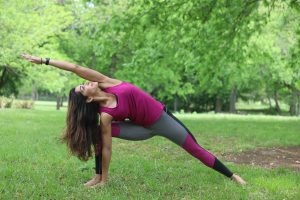
Summary
Spending our days at work, sitting in the same position has led to many people struggling with back pain, heart problems, poor posture and several other health issues. Simply by getting up and doing at least one of these yoga poses for a couple of minutes, every hour can help prevent these issues and have you feeling far more healthy. Even if you aren’t comfortable with doing these yoga poses, at least try to get up and go for a 2 or 3 minute walk every hour. Whatever you do, try and move as much as possible throughout the day. If you need more help learning how to do these yoga poses, there are plenty of resources online to show you step by step how to perform them. Be sure to listen to your body and if at any time you feel pain, gently remove yourself from that pose.

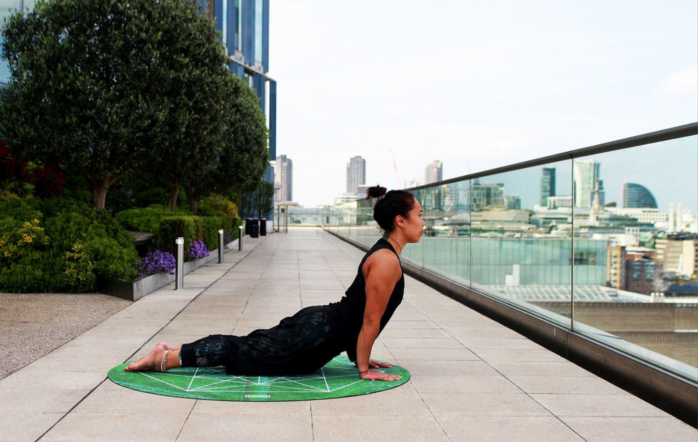
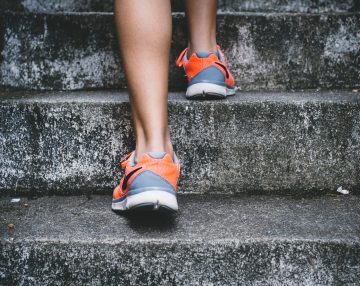

Leave a comment